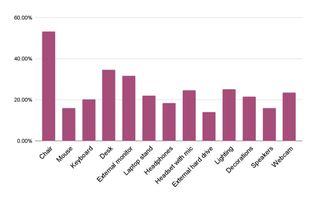Workers 'suffer more physical pain' as a result of remote working
Back and neck pain issues increase significantly over lockdown – what’s an employer’s responsibility?

More than a quarter of people who responded to a recent TechRadar Pro and SmartBrief survey reported they had experienced physical pain, such as neck or back pain, due to working from home during the pandemic.
In the survey of 1,200 US-based professionals, 90% of respondents said they had worked from home during lockdown, with 87% rating remote working comfort as either “important” or “very important”. Less than 3% said that comfort was “not important” when working remotely.
As many office employees will know, back and neck pain are common symptoms of working at a desk and can be alleviated by correct positioning of a monitor, sitting so that feet are flat on the ground, and by sitting in a good quality chair, which supports the natural shape of the back.
- Guide to the best VoIP services
- COVID-19: a defining moment for businesses’ data usage
- The best online collaboration software
Home office-equipment shopping spree
Perhaps as a way to make home offices more comfortable and productive, nearly two-thirds of respondents said they’d purchased office equipment during the lockdown, with less than a third of respondents (29%) saying they still planned to purchase office-related equipment.
More than half of those respondents planned on purchasing a new home office chair, with a new office desk (35%), external monitor (32%), and a headset with microphone (25%) likely purchases too.
Do you plan to purchase any of the following office-related items?


SmartBrief is the leading digital media publisher of targeted business news and information by industry. If you enjoyed this article, sign up for SmartBrief on Leadership for more insights like this delivered to your inbox daily, SmartBrief publishes more than 200 industry-focused newsletters.
The shift to a more flexible working workplace then appears to be a double-edged sword – benefiting employers and staff but also creating new issues that need to be resolved. But with many companies now insisting workers do work at least some days per week from home, the question is: who is responsible for workers’ health - and indeed equipment costs - when they are not on work premises?
Are you a pro? Subscribe to our newsletter
Sign up to the TechRadar Pro newsletter to get all the top news, opinion, features and guidance your business needs to succeed!
According to Worksmart, the employer is responsible for, “...the protection of the occupational health and safety of staff who work from home as well as office-based workers. This duty cannot be delegated to the worker, even though your employer is not in your home and cannot control what goes on there.”
Not only that, but the employer must carry out a risk assessment, and its duty extends to its employees’ “...mental health, including the risks of isolation, overwork, or failure to take proper breaks,” concludes Worksmart.
In the US, employers must have compliance with labor laws and consider the state laws of where the remote person works from, along with the broader Fair Labor Standards Act (FLSA).
That said, employees do share the burden in ensuring their own health and safety and are required to ensure their working environment is safe.
It's a complicated issue, which we've explore further in this article: Remote working and health and safety.
Read more about the results of this survey:
Nick Jones is a Content Director with over 20 years of experience writing about consumer and B2B technology and software, in both a content and marketing capacity. He has worked with myriad publications in that time and with many leading financial, technology, medical, and entertainment providers, including Cisco, Pfizer, and Virgin Media.

